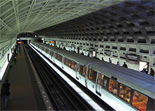How To Save Money When You Take the Subway To Work
Published 11/15/07 (Modified 3/9/11)
By MoneyBlueBook
 I live in the suburbs and commute into Washington D.C. for work every day. I actually have it comparatively easy since I don't have to commute through the notoriously jammed packed Beltway every morning. I tried driving to work for a while, but the frustration of dealing with daily rush hour traffic finally broke me down. With gas prices soaring and with more cars piling onto the roads than the day before, it just didn't make sense for me to commute by car anymore. So that's why I decided a few years ago to commute solely by subway, and I've never looked back since.
I live in the suburbs and commute into Washington D.C. for work every day. I actually have it comparatively easy since I don't have to commute through the notoriously jammed packed Beltway every morning. I tried driving to work for a while, but the frustration of dealing with daily rush hour traffic finally broke me down. With gas prices soaring and with more cars piling onto the roads than the day before, it just didn't make sense for me to commute by car anymore. So that's why I decided a few years ago to commute solely by subway, and I've never looked back since.
In the D.C. area we have an extensively used subway system, called Metro. Many commuters, particularly federal government workers who live in the Maryland and North Virginia suburbs commute into D.C. using the Metrorail system. Over the years I've learned a few cost and time saving tips for commuting to work via subway:
1) Know the weekday times for regular and reduced fare. The rules may be different in other major cities like New York, Philadelphia, or Boston, but the D.C. Metro charges a reduced fare when you ride during off peak times. The D.C. Metro regular fare is in effect on weekdays from opening to 9:30 a.m., 3:00-7:00 p.m., and 2 a.m. to closing). All other times are reduced fares.
The fare that you are charged depends on the time that you cross the gate. I always keep the peak hour times in my mind when I plan my commute schedule. The one I am most cognizant about is 7:00 p.m., since this is when the evening off peak fare goes into effect.
I usually get off work a few minutes before 7:00 p.m. Because reduced fare starts at 7:00 p.m. sharp, if I arrive at the gate a bit early, I always wait for the clock to turn 7:00 p.m. before I cross the ticket gate. After all, why not wait a few more minutes and enjoy the reduced price? Sometimes I get there at 6:56 p.m. only to see people rushing past me through the gate and be charged the higher rate. If they waited a few more minuets, they could easily save upwards of $1.50. This may not seem like much but it does add up, particularly if you commute every weekday of the year.
2) Know the subway map and alternative train routes to get to work and home. I'm not sure how reliable the subway systems are in other cities like New York, but in D.C., our subway trains recently have had the tendency to break down and spark mini fires. When that happens, commuter rail traffic grinds to a halt while workers clear the smoke and patch up the malfunction. This type of stoppage causes major delays and forces people to find alternate paths home. While some resort to paying for expensive taxi rides costing in excess of $30, I prefer to get to the surface and walk to an alternate station to bypass the stoppage. The alternative route may require a few extra train transfers, but it beats waiting a few hours for the delay to clear.
3) Buy your subway pass denomination in bulk and pocket the savings. In D.C. we use SmarTrip magnetic cards to store our subway funds. Each card can hold upwards of $300 at a time. I usually buy these cards on sites like eBay where I can acquire them at a substantial discount (search for SmarTrip deals). I usually can get a fully loaded $300 card for only $200. Generally, the higher the denomination you're willing to buy, the greater the savings you'll get. Don't expect to get much of a deal if you are only buying something like a $50 metro card.
January 1, 1970 at 12:00 am